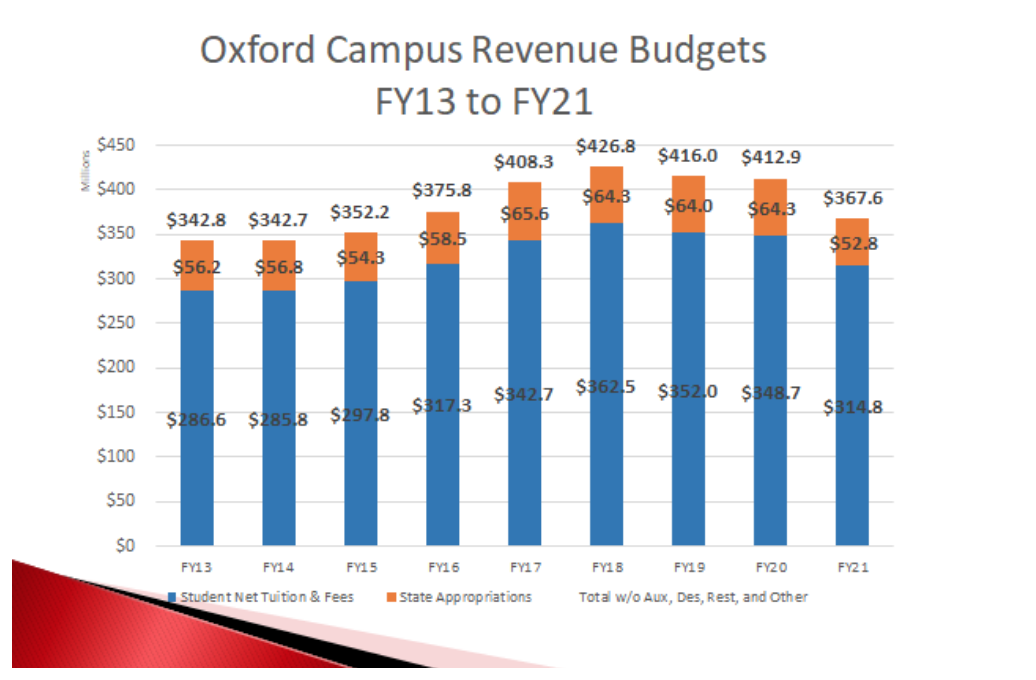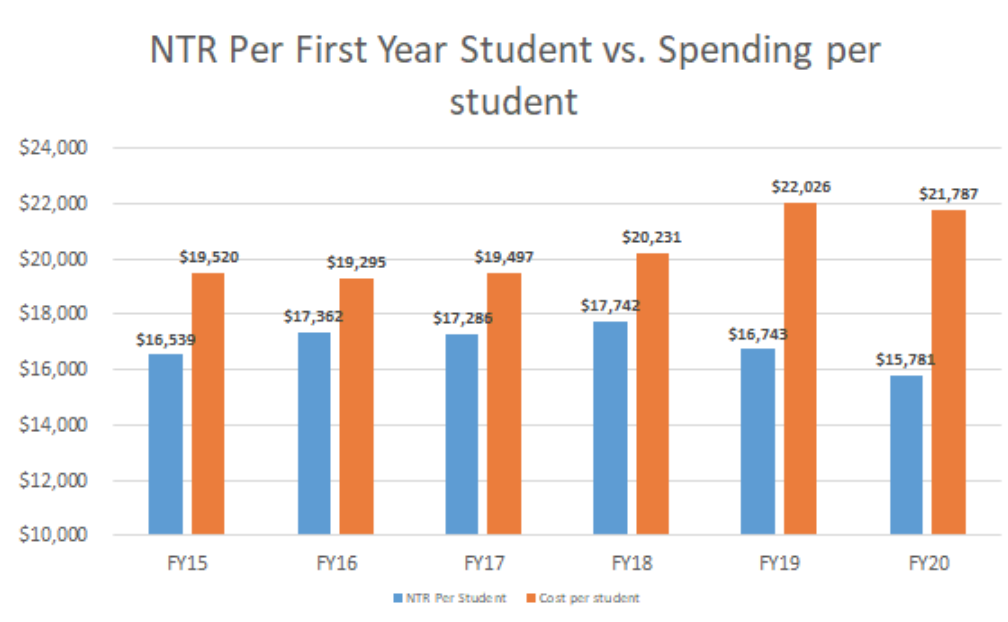6-27-20 Message to the Community

Dear Colleagues,
I hope this message finds you all doing well as we now are past the summer solstice and officially into our summer. At the meeting of the University Senate this past Monday, the Fiscal Priorities Committee discussed the budget updates shared at the meeting of the Board of Trustees on June 19th. I wanted to review the budget journey we have been on and summarize our current budget estimates for the fiscal year that begins July 1st (FY21).
Background
Oxford net instructional revenue, sometimes referred to as net tuition revenue, or NTR, has historically increased year over year, and recently peaked in FY18 (2017-18). Since that point, however, it has been declining, despite increased enrollment numbers. The regional campuses are following similar patterns and challenges.

Note that in the chart above, which was presented to the Board of Trustees, models a 20% cut to state support, which was our guidance at that time. This may change as the state better understands its situation.
As revenue increased through the period ending in FY18, three other things happened:
- Discounting and financial aid increased, matching national trends for stronger competition for students, and state support for higher education nationwide has declined, but these trends previously could be overcome with increasing NTR. The recent trend of declining NTR no longer allows us to offset these other trends;
- Fixed costs rose every year, due to things such as salary increments, increased utilities and infrastructure costs, subscriptions to journals, insurance, benefits, etc.;
- Some extra spending occurred to enable us to do things that are valuable for a strong liberal arts research university that values the teacher-scholar model.

COVID-19 has exacerbated this situation. Now, on top of institutional competition for students, many families are more likely to be facing grave financial challenges of their own. LIke most states, Ohio has also experienced significant revenue declines during COVID-19, which has led us to plan for reduced state support for FY21 and likely beyond. In the chart below, you can see the magnitude of the change in financial aid to undergraduate students over a relatively short period of time.

Because of these converging patterns of increased expenditures and costs combined with declining NTR, when I joined Miami in August, Academic Affairs (AAO) was spending $19 million dollars more than we were generating. While this deficit spending was being offset by carry-forward, this is not a sustainable long-term strategy. Before COVID, we had been planning on ways to constrain spending on visiting faculty and temporary staff as expenditures in this area had grown to exceed $35 million dollars per year.
Also prior to my arrival, Miami implemented an “agile budget model” which planned five years of reductions for all divisions, not just AAO, to reduce expenditures to acknowledge these declining revenues and to provide funds to reallocate into academic affairs. During the Fall of 2019, Dr. Creamer and his budget team notified the PEC that we were anticipating bigger financial challenges than previously anticipated, so there was an increase in reduction goals that were accelerated into the coming fiscal year (FY21). Every area of the university participated in this exercise. Additionally, Provost Callahan and the deans engaged in planning to reduce reliance on visiting faculty and to prioritize hiring based on need and strategic prioritization. The goal was to gradually, as opportunity arose, reallocate resources to growing areas of need and to begin constraining spending in light of revenue declines we were experiencing.
Boldly Creative
Boldly Creative was conceived as an initiative to help invest in the long-term health of the university, acknowledging that students will seek out unique, high-quality programs that also align with what they are seeking. The vision was to build new programs and to invest in revising existing programs to be more competitive, allowing us to attract more strong students with less discounting.
Another goal is to bring new revenue into the university. In academic affairs we have the capacity to implement new programs that can theoretically increase net revenue, such as new graduate programs, online programs, more Miami-led study abroad programs, increased sponsored programs expenditures, and increasing enrollment at our regional campuses. Our investments in these areas are intended to offset revenue declines, complement ongoing reallocation of resources, and continue positioning Miami as a desirable destination.
COVID-19
We are not finished with the pandemic, but many of you are familiar with the financial impacts it has already had on the University. We refunded over $27 million dollars to families in housing, dining, and other on-campus fees, and state support was reduced. When we modeled potential impacts of COVID on our FY21 budget back in March, the possibilities were alarming, particularly when combined with our existing budget deficit in AAO. Thus, we asked each department to reduce course offerings, increase course sizes, and to modify teaching expectations to reduce our expenditures in this area. It was not desirable, but had we not acted at that time, before fall course schedules were finalized and contracts were offered, we would have been left with much more unpalatable options.
As I write this, and assuming we can return students to campus for fall, we are expecting to have significant but manageable budget impacts. In May, our deans and support centers engaged in an exercise to identify $22.5 million dollars in reductions within AAO. Thanks to all the efforts of faculty and staff who engaged in calling our returning students, and supporting recruiting and retention efforts, we are now modeling an $8 million dollar reduction for AAO. All reductions across VP divisions were aligned in magnitude with fiscal and strategic needs. Our allocation of $8m is a smaller percentage of our divisional budget than other divisions experienced (< 6% vs 10-21% for other VP divisions), for which I am grateful.
Within AAO, we allocated $10 million dollars across units according to budgeting principles, such as asking colleges to align expenditures with resources. To that end, we allocated goals across the academic divisions to meet the necessary $8m reductions mandated by the budget office with some additional to reduce deficit spending. For divisions not in deficit, we allocated reductions where we thought operational spending could be targeted. Finally, support centers within AAO have been examined individually and budgets have been adjusted where there is capacity.
These exceptional efforts in reducing course offerings, increasing teaching responsibilities, and additional reductions in expenditures have moved us to a much more sustainable situation. Our Academic Affairs enterprise has moved from a deficit of $19 million a year ago to an anticipated deficit of around $2 million while also accounting for the reduced revenue described above. Importantly, academic divisions have made individual progress on net position; Remember, net position is a raw number indicating how much is spent vs. revenue generated:
- CAS has improved net position from -$12m to around -$4m;
- EHS has been net positive and retains a net positive position of around $1m;
- FSB was almost -$3m and has improved to near-balanced;
- CEC has been net positive and retains a net positive position of around $1m;
- CCA has been net negative and remains at around -$2m; and
- CLAAS has different revenue flow than Oxford but we expect to also see a net positive position of over $1m.
Looking Toward the Future: FY21
We cannot predict what this coming fiscal year will look like. If we are able to bring our students to campus, have a good campus experience, and do all the things we know can limit the spread of COVID-19, hopefully looking forward to a vaccine sometime this fall or winter, I am hopeful that this will be the bottom for us, and with all this work to streamline and reallocate and invest, we can have a bright future. If, on the other hand, we as a country cannot find our way toward reducing spread and infection as many other EU countries (and a few states) have, if Oxford, Hamilton, and Middletown cannot be trusted to provide a safe environment for faculty, staff, and students, and if we cannot host students on campus, we face revenue reductions far larger than we experienced during the spring semester. It would likely involve significant layoffs of our most vulnerable staff, and would also likely take us much longer to recover from. Everyone on the PEC is working to avoid these outcomes but we need everyone in the community, including our students, to help. These messages are being sent to our students, their parents, and other stakeholders. Next week I will provide more information on exactly how student life and other groups are working to set expectations and norms for our students, and how we are working with our city partners on these issues.
Longer Term Outlook
Miami has a strong national and internationalreputation. We have excellent faculty and staff, high-demand programs, a unique student experience, dedicated alumni and external partners, with an excellent track record of providing a strong return on investment for our students. I believe we will persevere through this dark time, and if we continue building the types of degree programs, co-curricular experiences, experiential learning opportunities, and reputation that our MiamiRISE strategic plan called for, I believe Miami has a bright future. We are often ranked as one of the most efficient universities in the nation, which also means that if we can grow revenue in the future, we can quickly pivot from financial restraint to investing in our priorities and mission.
I know these are not easy times. I hope that each of you can look past these short-term challenges and help co-create this hoped-for future. Aside from a global pandemic and budget challenges, we are challenged to live our values through our actions in other areas. We must continue to help our fellow Miamians live our Code of Love and Honor by understanding implicit and explicit biases and prejudices, becoming better allies, and being agents of change. We must take actions to ensure Miami remains a leading exemplar of a strong liberal arts university. We must ensure our students emerge as thoughtful, ethical, inclusive leaders steeped in the arts, humanities, social and physical sciences, who are communicators, entrepreneurs, and innovators, who are in high demand by organizations of all types because they are not just technically or professionally prepared, but because they are also well-rounded humans.
Many Thanks,
Jason Osborne

